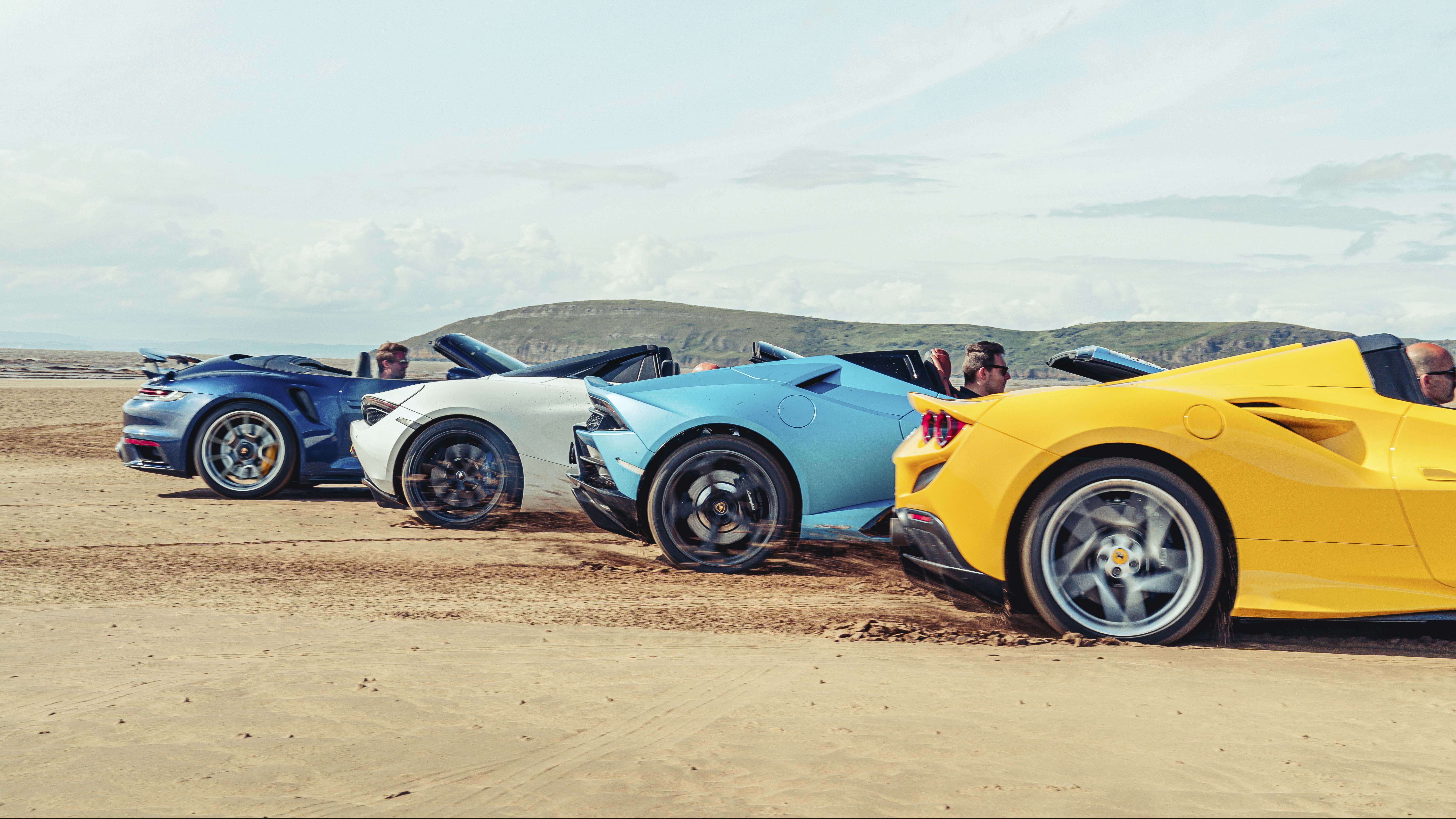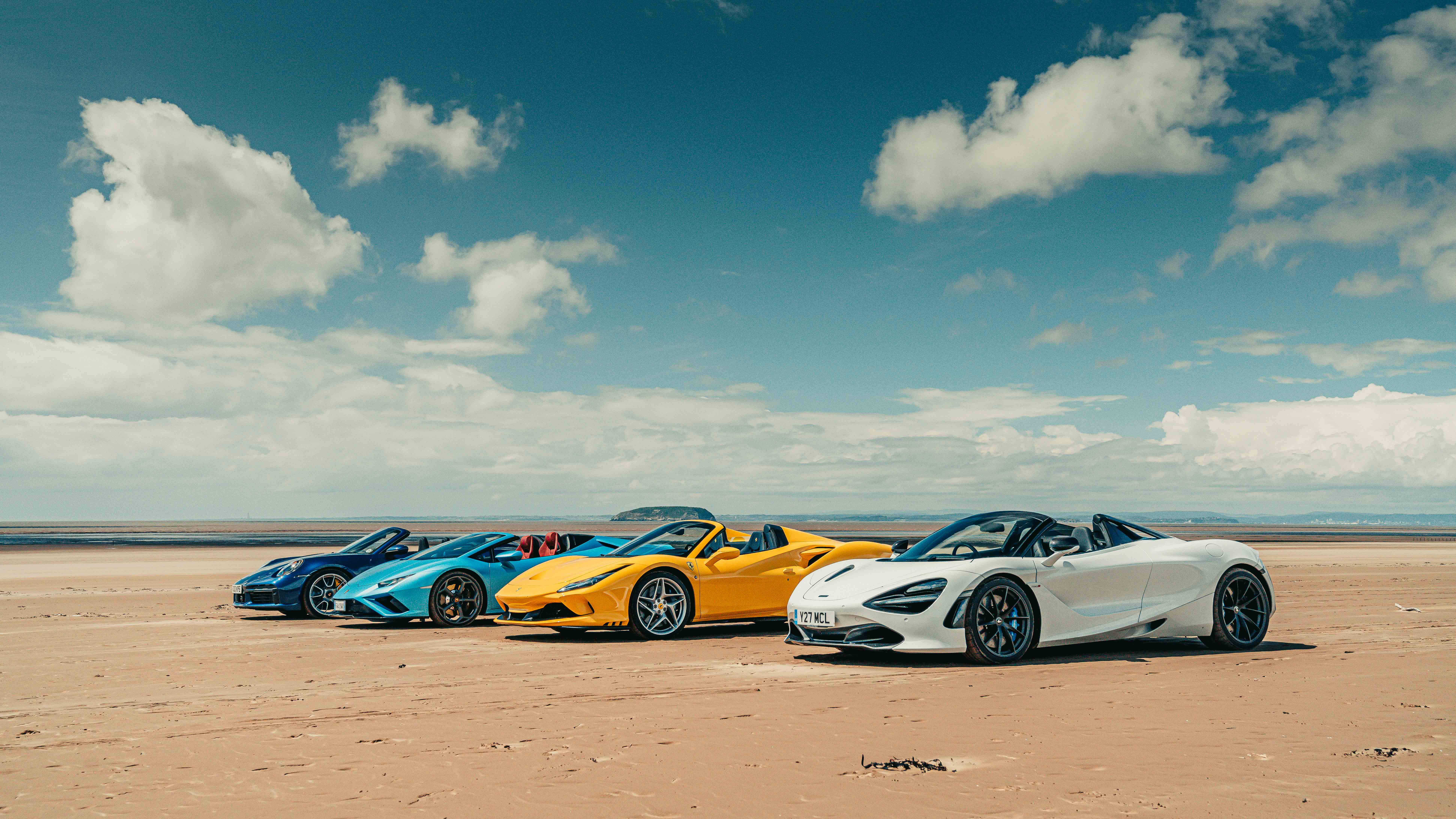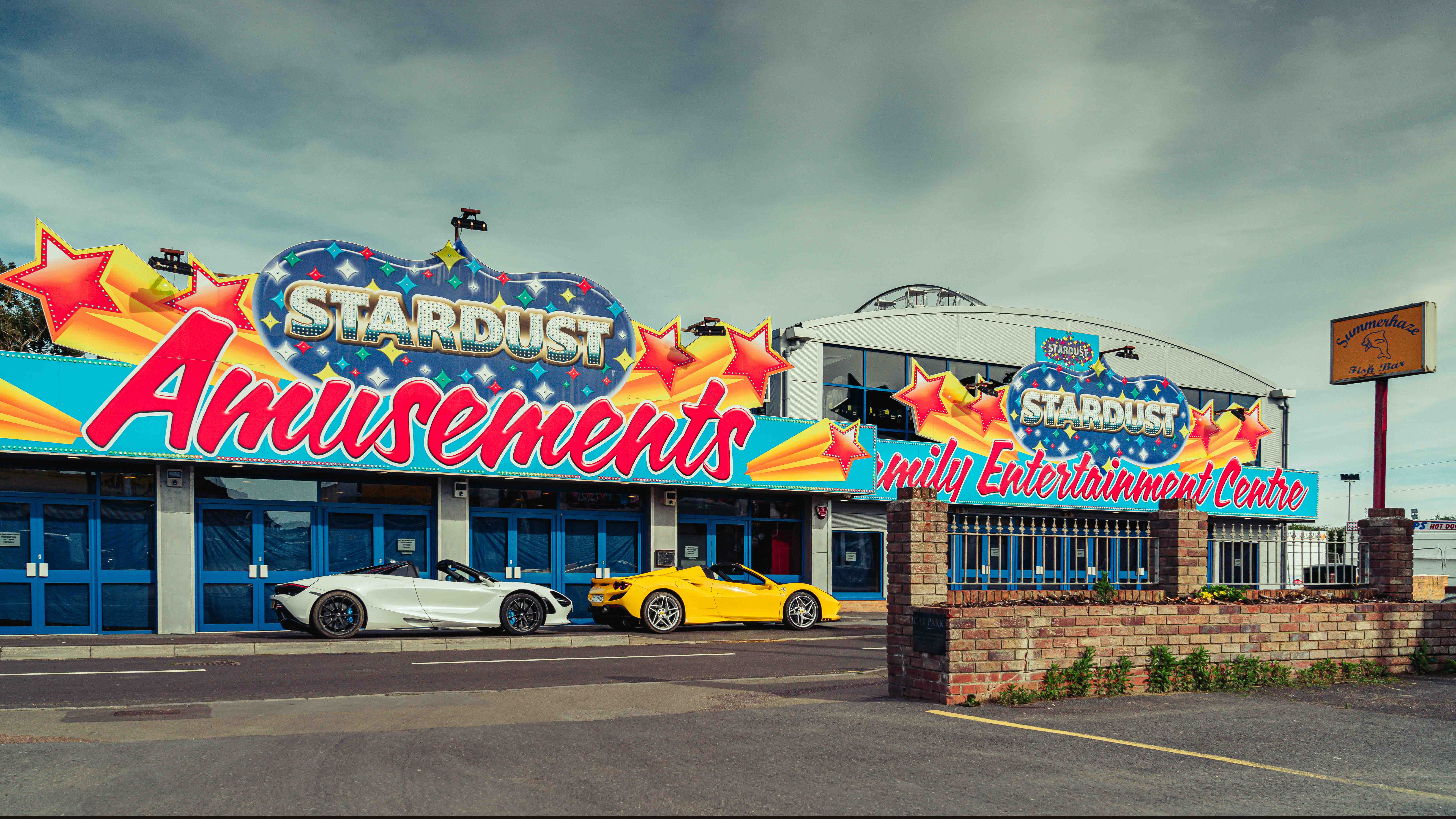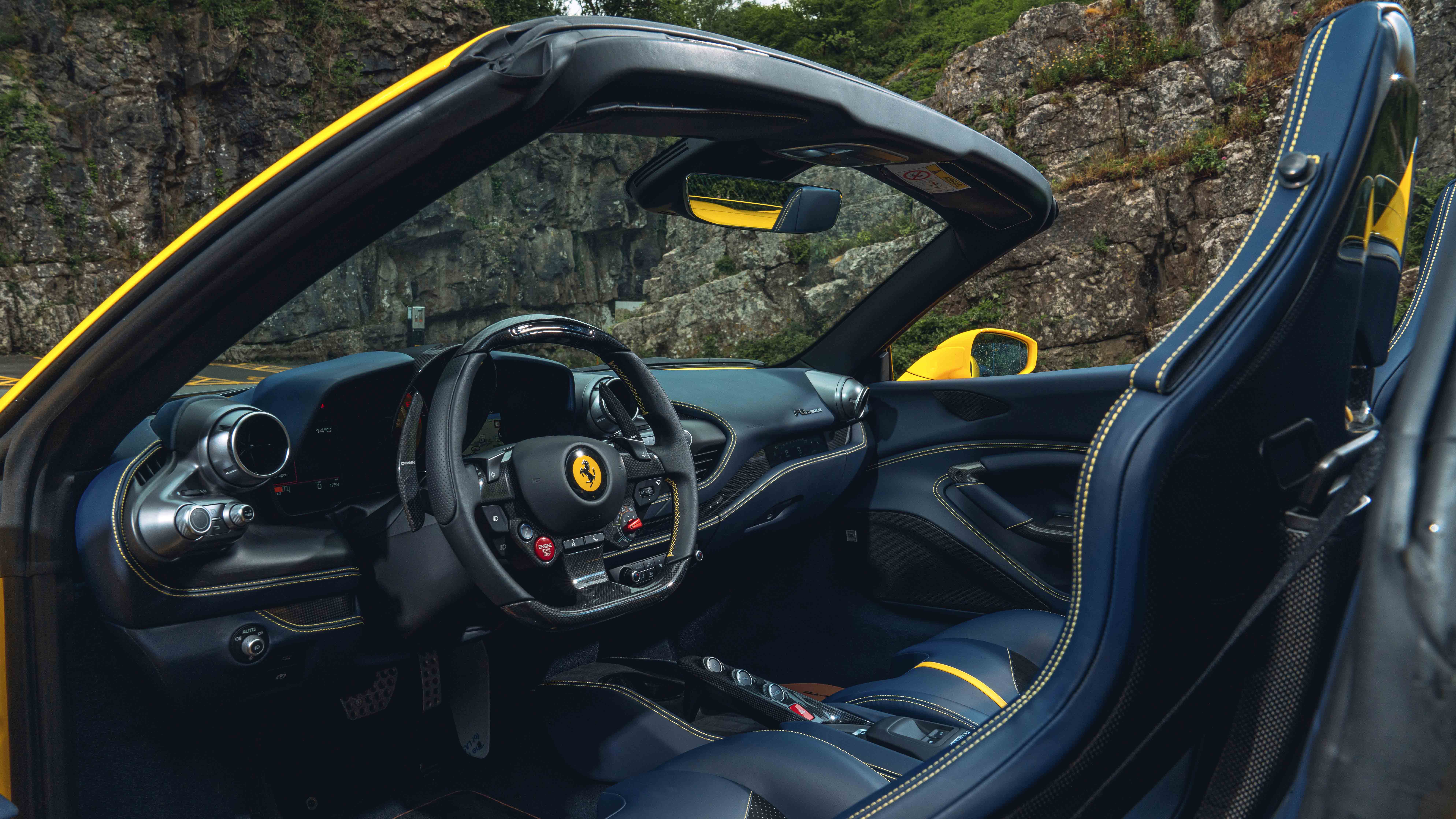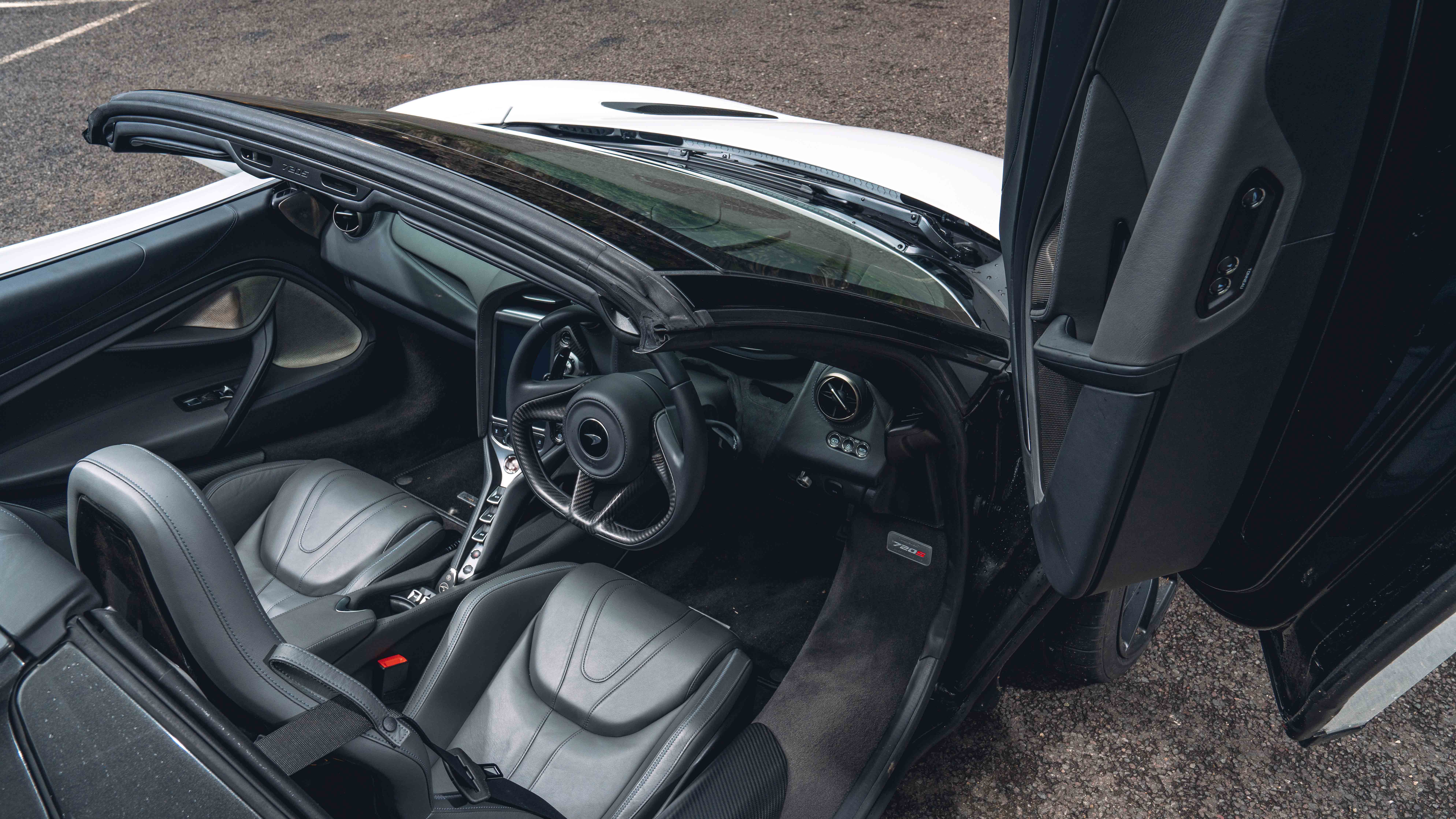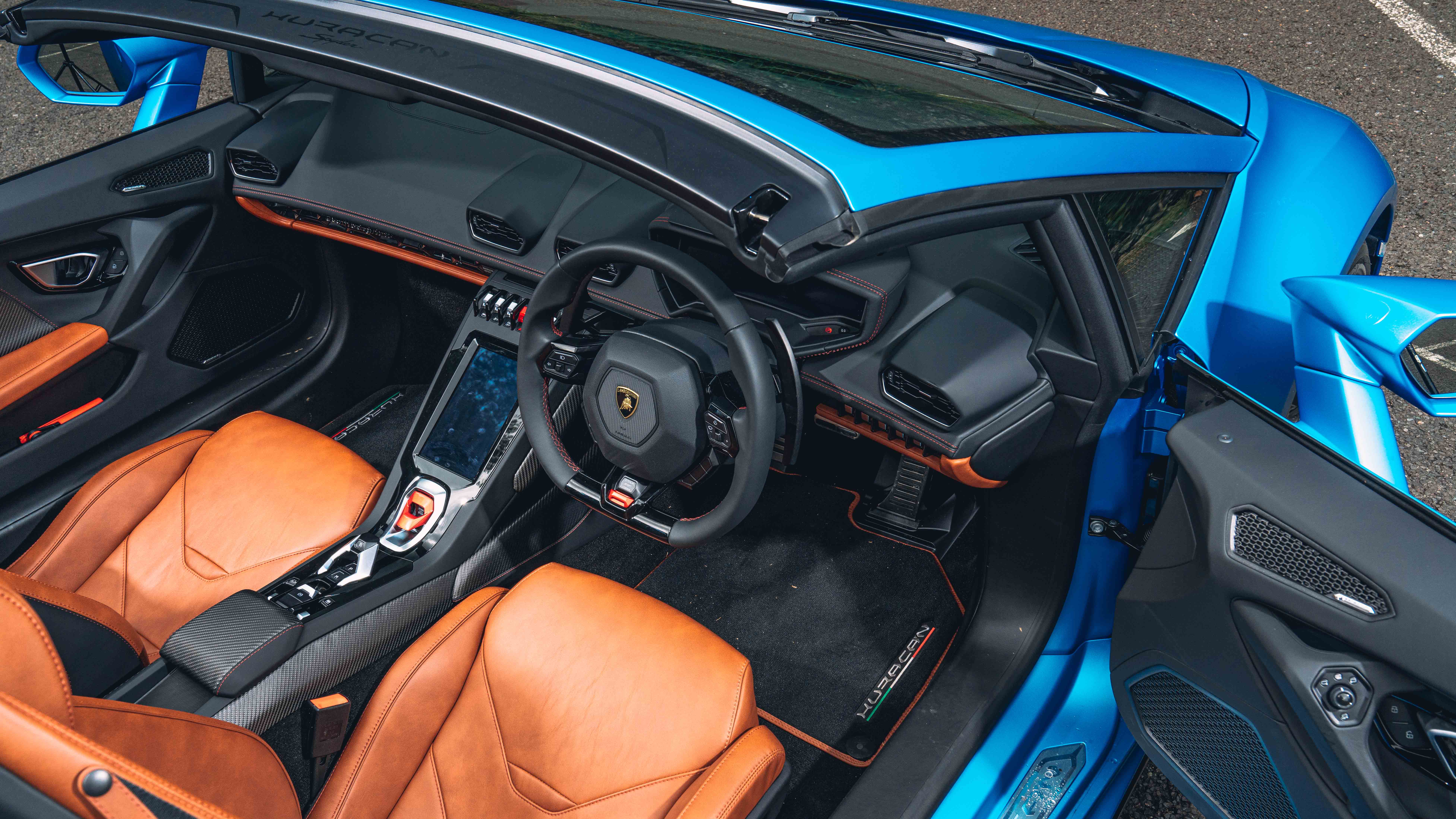
Super spiders: Ferrari F8 vs McLaren 720S vs 911 Turbo vs Huracan RWD
Does chopping the roof off a supercar ruin the magic? To the beach!
“Are you single?” The words are directed at Rowan Horncastle, who’s been cultivating what he refers to as a ‘Swedish billionaire’ look during lockdown. The rest of us refer to it as ‘Seventies TV presenter’, and will do doubly now it seems to have irritatingly attracted the right kind of attention. Charlie Turner and I - 15 years his senior, the former afflicted with an entirely voluntary Mexican moustache, the latter with a dome not of his own choosing, but so burnished and rounded it would make a Byzantine cathedral jealous - look on.
“You realise,” twitches the moustache, as we watch Rowan sashay off across the sand, “that you and I are now too old to pull off the yellow Ferrari roadster thing.” A discussion ensues. Under 35s only, is the conclusion. Maybe 40 at a push if you go for navy blue. Same applies to the Lambo, with the added proviso that you must also be short. If not, your head pokes out the top like a whack-a-mole. Or, if you’re me, something else entirely. The McLaren, that’s a bit more grown-up, and you’re fine to the grave in the Porsche.
I am making a point here. These are supercars. The only thing that separates them from their coupe cousins is that the roofs come off. And yet this small fact means we view them entirely differently. No longer are they steely-eyed, sinewy driving machines, now they’re just another means of conveying your wealth, along with your daft watch and sockless loafers (Rowan’s yet to conform).
Among us car people, the loss of status outweighs the loss of roof ten times over. It’s a question of perception. Once you realise the world around you is trying to work out if they’ve seen you on Made in Chelsea, you’re lost. But up to that point, away from chi-chi Mediterranean harbours and Mayfair hotels - and driven roof down through the swaying, chirruping countryside on a summer’s day with the sights, sounds and smells filtering in - these cars feel wonderful, multi-dimensional in a way the coupes aren’t.
These cars feel wonderful: multi-dimensional in a way the coupes aren’t
The Ferrari is newest. It’s the F8 Spider, although underneath not a great deal has changed from the 488, which itself had much in common with the 458. Brilliant cars, both. Power is up because that’s the only way it ever goes, aero efficiency is 10 per cent better, it’s a little lighter with more advanced chassis electrics and the same roof mechanism it’s had for the last nine years, a simple flip-up-and-over arrangement that’s noisier than the McLaren’s neater, faster, smarter operation, but takes up a tiny amount of space on the rear deck. They’re both foldaway hard-tops, while Lambo and Porsche prefer canvas. It’s clearly the cheaper method – before options both cars (the Huracán is an entry-level RWD version) sit the happy side of the £200k barrier.
That’s still a whole hill of money, so let’s take it as read that price is irrelevant. Yes, as tested the £178,414 Porsche is over £100,000 cheaper than either the McLaren or Ferrari. It’s no worse equipped and not much slower – all you’re missing is exclusivity and a frankly shameless attitude to charging for extras. May I present Apple CarPlay as evidence, which is free in the Porsche, £2,400 in the Ferrari. Or the fact the 911’s impressive Burmester hi-fi is half the price of the pretty ropey systems fitted to the others. And it’s not like the Turbo S is affordable: you can have a non-Turbo (but still turbocharged) convertible 911 for little more than half the cost. It’s all relative, and up in the automotive stratosphere the price is – perhaps fittingly – plucked from thin air. It exists as much to look impressive, as to represent value or worth.
The Porsche drives twice as many wheels as the others, sending power there from a 3.7-litre twin turbo flat six. The McLaren and Ferrari get four-litre twin turbo V8s with north of 700bhp, and there’s a naturally aspirated 5.2-litre V10 of considerable voice for the Huracán. Loose rocks were scattered in our layby at Cheddar Gorge, evidence the scenery does occasionally fracture and tumble. Each time someone clambered into the Lambo and flipped up the cover over the starter button, I carefully took up a position way out in the open. The coupe is rowdy enough, but the Spyder’s strident sonics scuttle deep into your ears. It’s a trumpeter, all pomp and stomp, the Italian national anthem piping from its posterior. Frantic tenor as the revs rise, bass rumbles when you lift off. The Gorge trembles at its passing.
The others, all gusty turbos, huff and puff along in its wake, asthmatic in comparison. It startles me to realise it, but it’s the Ferrari’s soundtrack that is the most disappointing. It drones. There’s a bit of volume, but it’s more Paxman than Pavarotti and doesn’t have the mechanical growl of the Porsche or the sharp hiss of the McLaren’s turbos. What it does have that they don’t, is response. How come every other supercar manufacturer hasn’t stripped this engine down, analysed it and copied it? You’d imagine they would, but if they have, why do they still suffer from turbo lag? Maybe it really is witchcraft after all. I drive the Ferrari and Lambo back to back and emerge convinced that the F8 has the most accurate and precise throttle response. Turbos beating a free breathing V10.
Above 4,500rpm the McLaren nearly matches it for response and actually betters it for speed, but you’re only at 4,500rpm when you want to be. In the real world, the one with traffic lights, changing speed limits and small gaps in traffic, you’re at 2,000rpm. That’s where you need instant thrust. And in the Ferrari you have it. Put it this way: it may sound a little flaccid, but I’d take this engine over any of the others in a heartbeat.
Top Gear
Newsletter
Thank you for subscribing to our newsletter. Look out for your regular round-up of news, reviews and offers in your inbox.
Get all the latest news, reviews and exclusives, direct to your inbox.
They are all crazily fast. Only the Lambo takes more than three seconds to hit 60mph, all can be at 130mph within 10 seconds. The Lambo turns this sprint into a stadium event – it’s a broadcaster in every sense, the most likely to draw a crowd, the most likely to back off halfway through when it realises it’s not going to win, showboating for the crowd instead. The McLaren goes in for intense focus. With its complex aero and carbon-fibre chassis (the only one here), it has the best power to weight ratio of the group, and seems to reshape itself under acceleration into a dart, focusing at some point ever further down the road. It knows it will win before the race starts, executing its plan and accomplishing its mission.
The Ferrari will be very close behind. The F8 basically uses the outgoing 488 Pista’s engine, so is up 50bhp on the GTB. Once again Maranello has engineered it to hold the torque back in lower gears, which means that each time the next pops home (which it does with a sneaky clutch surge), the acceleration seems to increase. The effect is an utterly relentless headlong rush for speed. There’s no time to breathe, no time you’re not in the fastest flow of the powerband. It leaves you breathless and trembling. And often unaware of just how fast you’re travelling. The dominant yellow centre dial is given over to revs and gear info, so unless you’ve got the correct display showing in the flanking screen, the speed reading is a footnote next to the remaining range.
The Porsche accelerates like a sneeze. There’s build-up before the main event, a tickle in the nostrils at 2,000rpm, a sense that the Turbo’s lungs are expanding under inhalation, a tense little pause as the needle rises past 2,500rpm, a few false ‘ahs’, and then at 3,000rpm there’s an enormous spit-flecked explosion. Happily, unlike a sneeze, it’s the kind that forces your eyes open. Wide open. Actually it’s more of an eruption, as it is sustained for as long as your bravery dictates. The Porsche has four seats and more weight than the others, but as a snapshot for your memory, these anticipatory moments as you wait for the hit are as addictively delicious as the whack in the back itself.
The 911’s turbos do take some managing though. Porsche has clearly decided that making the capital-T Turbo feel, well, more turbocharged, emphasising the lag rather than trying to banish it, is the way to set it apart. Through the twists and turns of Cheddar it means you have to keep a gear lower, make the engine bubble and fizz more hungrily if you want to exit corners with the force the Turbo S is capable of generating. And it is a frighteningly forceful car, the best at maintaining momentum when the inevitable happens and the heavens open, sending torrents down the road.
For the next few hours all we learned between the showers was that the McLaren’s roof (ten seconds for the complete operation, but the panel over your head in only seven) is the fastest and quietest, and leaves you with the lightest cabin thanks to the £7,500 electrochromic roof panel. I’m going to ignore the car’s spec – not so much the white paint, as the pleblon grey cabin, as toneless and dull as a Ron Dennis monologue. You need to see past that to the efforts McLaren has gone to to give the 720S a sense of vibrancy: the flip-panel dashboard; the perfectly sized, positioned and shaped steering wheel; upward-lifting, outward-twisting doors; the buttress that holds the gearbox buttons.
After it, the Ferrari feels lazily familiar. Not much has changed. Yes, you can now have a display in front of the passenger, so maybe have them shout your speed to you instead of you searching for it. And CarPlay appears, but on a screen no bigger than your phone and operated by a twist knob on the dash. Just like the cruise control. The Ferrari is not good at being easy to use if you’re pootling around. It wants you to drive. That’s why revs dominate the dash, and thumb-reach controls litter the steering wheel.
The Porsche’s cabin has more in common with an Audi than it does with its rivals here. It is organised in the same way, operates with the same clarity and ease, but doesn’t feel special or unique, just well put together and logical. The Lamborghini, despite being under Audi ownership, is a law unto itself. You can rub along with it, but just wait until you drop the roof and realise the upward facing console screen is now reflects so viciously you need to shield your eyes.
The bigger issue is where you’re positioned in the Huracán. The McLaren, Porsche and Ferrari tuck you down. The Lambo sits you on. As a result it has the most turbulent cabin; if you’re tall the windscreen rail will be at your eyeline. It’s a long way forward, so you shouldn’t headbutt it, and it certainly enhances the sense of exposure, but pop the roof up and it’s cramped and dark. Tiny boot up front and zero space behind the seats. None of the two seaters buck that trend, but all do better up front.
Kites, a cricket bat, badminton set, balls, frisbee and buckets all slotted in the Ferrari, because we were off to the beach. It should have been that afternoon, but the weather intervened, so we headed home to regroup the following day at Brean Sands. By pure coincidence Rowan, Ollie Kew and I hook up at Membury services. Ollie doesn’t jump nearly as high as I wanted him to when I creep up on him and beep the horn. I realise he’s already spent two hours in the Lamborghini, so will be deaf. When we depart onto the M4, the 720S grunts, whistles and is gone. The Lambo, with three times the apparent effort, moves visibly more slowly. I’m in the 911. I’ve pulled paddles and am in fifth already. They’re specks by the time the 911 gets a tickle in its nostrils.
We’re out driving on some good roads. The sort that are unkind to roadsters
But at the other end of the M4: 30.3mpg, 26 for the McLaren, 23 for the Lambo, which, like the Ferrari pulls over 2,500rpm at 70mph, while the Anglo-Deutsch consortium potter along in top at around 1,700rpm. It’s been amusing to watch Kew’s barnet buffet in the breeze, and to be honest the best place to appreciate the Lambo’s V10 soundtrack is a position about 200 yards behind it. That way you can’t be blamed. The Lambo looks hunched, like it’s tucked its head into its shoulders, whereas the Porsche is more hump-backed, the visual weight placed squarely over the rear axle. Both decks are challenging to see over.
The beach at Brean is near enough seven miles long. We’ve got the first mile to play with, as long as we avoid beachmats, dogs and sandcastles, and at up to a heady 15mph. We’re not here to learn about the cars, but we are here to see how other people react to them; with considerable excitement and then sucked teeth when they learn the prices. A straw poll suggests the Lamborghini strikes the biggest chord, because as one chap put it, “I had a poster of a girl in a bikini sitting on a Countach when I was young. That stuff sticks with you.”
It’s later and we’re out driving on some good roads. Some good, bumpy roads. The sort that are unkind to roadsters. Not the McLaren. What an astonishing car. Nothing deviates it from its course or causes it to lose control. All wound up it is incredible – you sit with your feet thrust into the nose, viewing the action up close with the front seeming to swing from under you. It has fabulous steering, outrageous speed, and tactility is undiminished compared with the coupe. It is a brilliant communicator, and aside from brakes that have too much travel before they bite properly, is savagely exciting to drive. Not playful, plain determined. Chassis tremble has been ruthlessly purged.
The others all suffer to some degree. The Lambo is commendably free from shake, but then you turn into a corner and it’s not as direct, eager and incisive as it should be. Some measure of flex is delaying the signals and you don’t get the coupe’s sense of connection to the front wheels. The back axle yes, but the nose has lost its brightness.
Similarly, the drop-top 911’s front end isn’t as tenacious as the coupe’s, but for a car with such a large open area, there’s very little shake indeed. It doesn’t so much shudder as twitch: a small movement, instantly corrected. The Ferrari, amazingly, has more difficulty keeping control of itself. Here, the movement when it hits a lateral ridge is a shiver up the spine that makes it as far as the steering wheel. And yet this doesn’t disrupt the lines of communication. Aside from the engine noise and this hint of flex that can’t help but mildly pollute the driving, the F8 is a sparkling car to drive. It’s more beguiling and vivacious than the McLaren and Porsche, more alert and alive than the Lamborghini. It flows beautifully on any road, at any speed. The McLaren is more focused, even better resolved, but not quite as effortlessly carefree.
Both these, and the Porsche, know how to kick back, cool off and cruise. The Lamborghini just misses the mark there. It’s the least resolved of this quartet, dominated by its barking engine. It wears its heart on its sleeve, but that just reminds you it has less depth than the others. Intending this as regular driver? Get the Porsche and ignore the sneers about it being a convertible. They’ll only be jealous when four-up you head off for your first post-lockdown run to a country pub.
The Ferrari F8 feels like an interim measure and, I’m afraid, like it hasn’t yet caught up with the technical advances McLaren made with the 720S. Put those to one side and you’ll fall for the Ferrari. It’s the most exciting car here. But overall the McLaren does the job better. As far as the job matters. Want some advice? Have the one that suits you best. Handily we reckon that’s the McLaren for our Swedish billionaire. Not sure which one we would put our Seventies TV presenter in. I don’t think they’re going in for roadsters these days.
Photography: Mark Riccioni
Thanks to: Brean Parish Council and the National Trust




